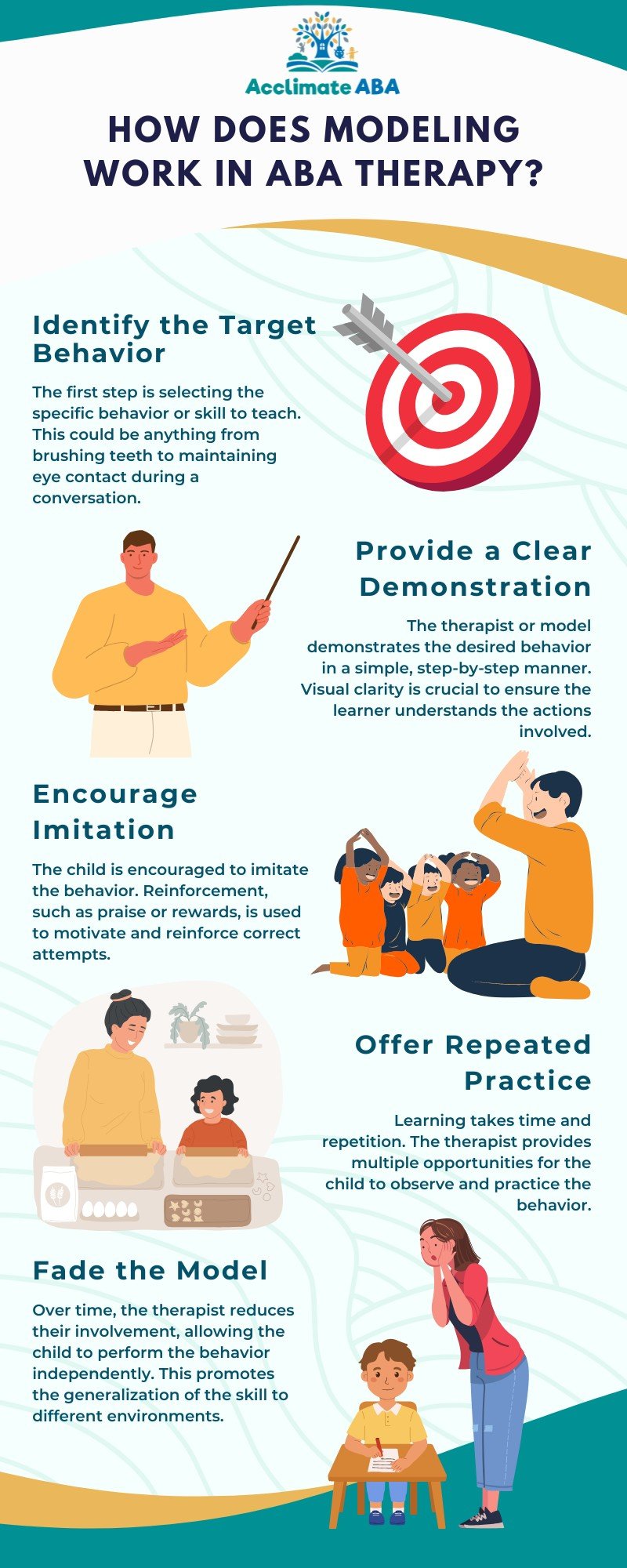How Modeling Works in ABA Therapy: Techniques & Benefits

Key Points:
- Modeling in ABA therapy involves demonstrating desired behaviors for the learner to imitate.
- It is used to teach skills like social interactions, communication, and daily living tasks.
- Modeling techniques can be direct or video-based, helping children with autism learn through observation.
Parents often notice their child struggling to pick up certain skills, whether it’s interactions, daily routines, or communication. It can be challenging to understand how to help when traditional teaching methods don’t seem to work. That’s where ABA therapy, particularly modeling, becomes a valuable tool. By showing children exactly how to perform a task or behavior, modeling provides an effective way to teach skills that might otherwise seem out of reach.
What is Modeling in ABA Therapy?
Modeling in ABA therapy is a technique where a therapist, parent, or peer demonstrates a desired behavior, allowing the learner to observe and imitate it. This method helps children learn by example and is particularly effective for behaviors that are difficult to explain verbally.
For example, a therapist might show a child how to greet someone with a handshake or how to tie their shoes. By watching the demonstration, the child gains a clear understanding of what the behavior looks like, making it easier to replicate. Modeling can be used across various settings, from therapy sessions to home and school environments.
Modeling leverages the natural ability to learn through observation. It works by breaking complex behaviors into smaller, manageable steps, making them easier for the learner to grasp. Here’s a breakdown of how modeling is implemented in ABA:
Benefits of Modeling in ABA Therapy
Modeling is a powerful tool in ABA therapy because it provides a visual example of what success looks like. The benefits include:
-
Enhanced Learning Through Observation
Modeling taps into the natural ability to learn by watching others. This approach is particularly effective for children who struggle with verbal instructions.
-
Teaches Complex Behaviors
Some skills, like tying shoes or resolving conflicts, can be difficult to teach using words alone. Modeling simplifies these processes by showing exactly how they’re done.
-
Promotes Skill Generalization
Once a child masters a behavior through modeling, they are more likely to apply it in real-life situations. For instance, learning to greet someone in therapy may translate to greeting peers at school.
-
Builds Confidence
Observing successful behavior demonstrations helps children feel more confident in their ability to perform the task themselves.
-
Flexible and Adaptable
Modeling can be used in various formats, including live demonstrations, videos, or role-playing, making it adaptable to individual learning styles.

Types of Modeling in ABA Therapy
There are several types of modeling used in ABA therapy, each tailored to meet the needs of the learner. These include:
1. Live Modeling
In live modeling, a therapist or peer demonstrates the behavior in person. For example:
- A therapist shows how to play a game.
- A sibling demonstrates how to take turns during a conversation.
Live modeling is especially effective for behaviors requiring real-time interaction, such as social skills.
2. Video Modeling
Video modeling uses pre-recorded videos to demonstrate the target behavior. This method is helpful for children who learn better with repeated visual exposure. Types of video modeling include:
- Basic Video Modeling: The child watches a recording of someone performing the behavior.
- Self-Modeling: The child is recorded performing the behavior correctly and later watches the video to reinforce the skill.
Video modeling is widely used for teaching routines, academic skills, and even emotional regulation.
3. Peer Modeling
Peer modeling involves using a peer of similar age to demonstrate the behavior. Children are often motivated to imitate peers, making this technique highly effective for teaching social interactions.
How Can Parents Incorporate Modeling at Home?
Parents are essential partners in their child’s ABA journey, and modeling can easily be integrated into daily routines. Here’s how:
- Be a Role Model
Demonstrate behaviors you want your child to learn, like saying “please” and “thank you” or staying calm during stressful situations. - Use Videos
Find or create videos that show desired behaviors, like brushing teeth or tying shoes. These can supplement live modeling. - Practice Daily
Repetition is key. Provide regular opportunities for your child to observe and imitate behaviors in natural settings, like during family meals or playtime. - Celebrate Success
Praise your child for their efforts, even if their imitation isn’t perfect. Positive reinforcement encourages them to keep trying.
Transform Learning with Acclimate ABA
Understanding how modeling works in ABA therapy gives you a powerful tool to support your child’s growth. Whether teaching social skills, communication, or daily routines, modeling helps children learn effectively by observing and imitating. It’s a versatile technique that builds confidence, encourages independence, and supports meaningful progress.
At Acclimate ABA, we specialize in providing personalized ABA therapy that incorporates evidence-based techniques like modeling. Our team is dedicated to helping your child achieve their full potential through tailored interventions that fit their unique needs.
We proudly serve families in Utah and surrounding areas. Contact us today to learn how we can support your child’s journey toward success through ABA therapy!

